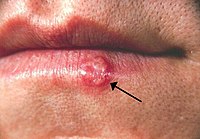
Photo from wikipedia
Methods Patients undergoing PCI to left anterior descending (LAD) bifurcation lesions with contemporary DES were analyzed from a nationwide registry. Baseline risk was assessed using the Age, Creatinine, and Ejection… Click to show full abstract
Methods Patients undergoing PCI to left anterior descending (LAD) bifurcation lesions with contemporary DES were analyzed from a nationwide registry. Baseline risk was assessed using the Age, Creatinine, and Ejection Fraction (ACEF) score. Target lesion failure (TLF), a composite of cardiac death, target vessel myocardial infarction, and target lesion revascularization, was assessed at 3 years. Results Among 1,089 patients with LAD bifurcation lesions, 548 (50.3%) patients underwent SB treatment. The SB treatment group showed a nonsignificant, but numerically lower rate of 3-year TLF (6.6% vs. 9.2%, HR 0.75, 95%CI 0.44–1.28, p = 0.29). In patients with low pretreatment risk (ACEF<1.22), SB treatment was associated with a lower rate of 3-year TLF (HR 0.43, 95%CI 0.19–0.96, p = 0.04), while no significant difference was observed in patients with high risk (ACEF≥1.22). The difference in the low risk group was mostly driven by target lesion revascularization (HR 0.24, 95%CI 0.08–0.75, p = 0.01). Conclusions SB treatment for LAD bifurcation lesions showed favorable long-term outcomes compared with main-branch-only intervention, especially in patients with low pretreatment risk.
Journal Title: Journal of Interventional Cardiology
Year Published: 2020
Link to full text (if available)
Share on Social Media: Sign Up to like & get
recommendations!